
|
Now it is 6.8 mag (Oct. 7, Seiichi Yoshida). It keeps so bright as 6-8 mag for a long time from 2011 to 2012, and will be observable in good condition in the Northern Hemisphere. In the Southern Hemisphere, it keeps observable in mid October.
Date(TT) R.A. (2000) Decl. Delta r Elong. m1 Best Time(A, h)
Oct. 8 17 58.08 19 6.1 1.778 1.868 79 6.7 18:59 ( 69, 58)
Oct. 15 17 49.67 18 52.6 1.856 1.818 72 6.7 18:50 ( 75, 52)
|
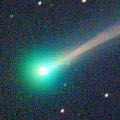
|
It passed very near by the earth, within 0.1 A.U., and brightened up to 8.0 mag in the southern sky (Aug. 14, Willian Souza). It appeared in the morning sky in the Northern Hemisphere. It brightened up to 6.6 mag in late September (Sept. 25, Juan Jose Gonzalez). Now it is fading, but still bright as 7.3 mag (Oct. 7, Katsumi Yoshimoto). It keeps observable while fading gradually after this. In the Southern Hemisphere, it is not observable until winter when it becomes fainter than 16 mag.
Date(TT) R.A. (2000) Decl. Delta r Elong. m1 Best Time(A, h)
Oct. 8 10 49.88 7 17.3 0.980 0.565 33 8.2 4:35 (271, 14)
Oct. 15 11 13.70 5 41.1 1.120 0.630 33 9.2 4:41 (274, 15)
|

|
Now it is 10.3 mag (Oct. 1, Juan Jose Gonzalez). It keeps 10 mag until November. In the Northern Hemisphere, it keeps observable for a long time until 2012 spring. In the Southern Hemisphere, it is not observable until November.
Date(TT) R.A. (2000) Decl. Delta r Elong. m1 Best Time(A, h)
Oct. 8 7 27.95 49 56.7 1.789 2.028 88 10.5 4:35 (225, 65)
Oct. 15 7 13.03 48 41.9 1.670 2.047 97 10.5 4:41 (215, 72)
|
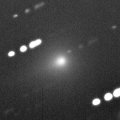
|
It has brightened faster than expected, and reached up to 8.1 mag in mid August (Aug. 19, Michael Mattiazzo). However, it turned to be fading and got diffuse rapidly after that. It has become fainter than 10.5 mag and unable to be detected in mid September (Sept. 14, Michael Mattiazzo). Now it is appearing in the morning sky. However, the comet was not found, fainter than 17 mag (Oct. 6, Leonid Elenin). It can have already disappeared. It will be observable in the excellent condition at midnight after this. Maybe the remnant of the comet can be detected. Juan Jose Gonzalez reported that a 10.7-mag diffuse comet was visible on Oct. 9.
Date(TT) R.A. (2000) Decl. Delta r Elong. m1 Best Time(A, h)
Oct. 8 10 49.29 12 50.5 0.263 0.800 35 10.5 4:35 (266, 17)
Oct. 15 9 24.96 22 23.3 0.235 0.922 64 10.8 4:41 (274, 46)
|

|
New comet discovered in the spacecraft images. It was observed so bright as 9.4 mag (Sept. 22, Chris Wyatt). In the Southern Hemisphere, it must have located high and been observable in excellent condition from spring to summer. Now it is not observable. In the Northern Hemisphere, it will appear in the morning sky at 15 mag in late November, then it will be observable while fading gradually. In the Southern Hemisphere, further observations are very hard.
Date(TT) R.A. (2000) Decl. Delta r Elong. m1 Best Time(A, h)
Oct. 8 14 19.99 -7 13.8 2.010 1.145 21 11.7 18:59 ( 82, -1)
Oct. 15 14 21.51 -5 17.7 2.102 1.176 16 12.0 18:50 ( 86, -3)
|

|
Now it is very bright as 11.0 mag (Oct. 1, Juan Jose Gonzalez). It will be observable in good condition at 11-12 mag in autumn and winter.
Date(TT) R.A. (2000) Decl. Delta r Elong. m1 Best Time(A, h)
Oct. 8 23 40.80 3 19.8 1.185 2.158 162 12.2 22:33 ( 0, 58)
Oct. 15 23 38.03 2 26.4 1.195 2.138 154 12.1 22:03 ( 0, 57)
|
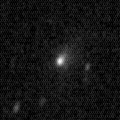
|
It brightened up to 15.0 mag on July 10 (Ken-ichi Kadota). The condition of this apparition is bad. In the Northern Hemisphere, it is only observable from December to February in the evening very low sky after the perihelion passage. In the Southern Hemisphere, it keeps observable for a long time, although it keeps locating extremely low. The component B was not detected, fainter than 20 mag, on May 14 (Hidetaka Sato).
Date(TT) R.A. (2000) Decl. Delta r Elong. m1 Best Time(A, h)
Oct. 8 14 46.70 -16 50.4 1.673 0.952 30 12.2 18:59 ( 70, -1)
Oct. 15 15 17.98 -20 7.3 1.640 0.943 31 12.1 18:50 ( 65, -1)
|

|
It will brighten up to 11 mag in autumn. However, it is not observable at all due to the bad condition in this apparition.
Date(TT) R.A. (2000) Decl. Delta r Elong. m1 Best Time(A, h)
Oct. 8 11 55.91 2 37.8 2.076 1.151 16 13.5 4:35 (266, -2)
Oct. 15 12 23.21 0 15.1 2.040 1.117 16 12.7 4:41 (268, -2)
|
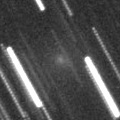
|
Extremely diffuse. It is faint as 15.0 mag by CCD observations (Aug. 20, Michael Jager). The central part is extremely faint as 18 mag. However, it was reported so bright as 9.5 mag visually (Sept. 25, Juan Jose Gonzalez). In the Northern Hemisphere, it keeps locating higher than 20 degree from November to December. In the Southern Hemisphere, it is not observable until November. It may disappear in the near future.
Date(TT) R.A. (2000) Decl. Delta r Elong. m1 Best Time(A, h)
Oct. 8 11 23.98 13 1.5 1.808 1.049 28 13.2 4:35 (261, 11)
Oct. 15 11 29.99 7 58.3 1.839 1.117 31 13.4 4:41 (269, 13)
|
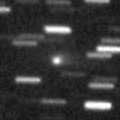
|
It brightened rapidly and reached up to 12.9 mag (Oct. 8, Seiichi Yoshida). It will be obserbale at 13-14 mag in good condition in autumn. It locates somewhat low in the Southern Hemisphere.
Date(TT) R.A. (2000) Decl. Delta r Elong. m1 Best Time(A, h)
Oct. 8 8 24.17 8 20.2 1.456 1.429 68 13.6 4:35 (296, 44)
Oct. 15 8 46.05 8 9.1 1.420 1.425 69 13.4 4:41 (298, 46)
|

|
Now it is so bright as 13.0 mag (Sept. 1, Hidetaka Sato). It keeps bright as 13-14 mag for a long time after this until 2013. It is not observable in the Northern Hemisphere, but it is observable in good condition in the Southern Hemisphere.
Date(TT) R.A. (2000) Decl. Delta r Elong. m1 Best Time(A, h)
Oct. 8 12 5.19 -77 21.8 5.716 5.490 72 13.5 4:35 (345,-35)
Oct. 15 12 14.87 -78 14.3 5.737 5.485 70 13.5 4:41 (346,-34)
|

|
Now it is bright as 13.8 mag (Sept. 22, Hidetaka Sato). It is observable in good condition in the Southern Hemisphere. But it will be getting lower, and will be unobservable in early November. It will brighten up to 11-12 mag in winter, however, it is not observable around the perihelion passage. In the Northern Hemisphere, it is not observable until 2012 summer, when it will be fainter than 15 mag.
Date(TT) R.A. (2000) Decl. Delta r Elong. m1 Best Time(A, h)
Oct. 8 15 21.88 -34 27.9 2.577 2.000 44 13.8 18:59 ( 51, -6)
Oct. 15 15 40.02 -33 47.0 2.563 1.932 41 13.6 18:50 ( 52, -5)
|

|
Now it is 14.3 mag (Sept. 13, Artyom Novichonok and Vladimir Gerke). It was observed much brighter visually around 10-12 mag. It keeps the current brightness from 2011 summer to 2012 summer. But it is not observable around the perihelion. It is already too low to observe in the Southern Hemisphere. It will be unobservable also in the Northern Hemisphere in November.
Date(TT) R.A. (2000) Decl. Delta r Elong. m1 Best Time(A, h)
Oct. 8 15 22.98 0 2.9 3.178 2.469 38 13.9 18:59 ( 78, 16)
Oct. 15 15 36.26 -1 30.3 3.194 2.446 35 13.8 18:50 ( 78, 14)
|

|
First return of a new periodic comet which brightened up to 13 mag in a major outburst in 2005. Now it is bright as 11.2 mag (Oct. 1, Juan Jose Gonzalez). It will be fading after this. But it keeps observable in good condition until winter when it fades out down to 17-18 mag. The fragment B is also observed at 20 mag. Another fragments C and D are also observed at 21-22 mag.
Date(TT) R.A. (2000) Decl. Delta r Elong. m1 Best Time(A, h)
Oct. 8 22 38.74 4 10.9 1.371 2.273 146 13.9 21:32 ( 0, 59)
Oct. 15 22 37.69 4 5.1 1.436 2.291 139 14.1 21:03 ( 0, 59)
|

|
Big asteroid discovered in 1906. It suddenly showed the cometary activity on Dec. 11, probably due to an impact of a small object. It was very bright as 11.5 mag visually (Dec. 17, Juan Jose Gonzalez). It had a dust coma still on Jan. 9 (Joseph Brimacombe). Then it turned to be stellar at 13.8 mag (Apr. 5, Juan Jose Gonzalez). Now it is not observable.
Date(TT) R.A. (2000) Decl. Delta r Elong. m1 Best Time(A, h)
Oct. 8 12 50.66 4 53.6 3.603 2.627 10 14.1 4:35 (256,-11)
Oct. 15 13 2.05 3 33.0 3.582 2.617 12 14.2 4:41 (260, -8)
|

|
Now it is 13.9 mag and visible visually (Sept. 26, Jakub Koukal). It will be observable at 13-14 mag for a long time from 2011 to 2012. However, it will be unobservable temporarily from November to January.
Date(TT) R.A. (2000) Decl. Delta r Elong. m1 Best Time(A, h)
Oct. 8 17 56.92 -11 28.6 5.497 5.332 75 14.2 18:59 ( 39, 34)
Oct. 15 17 55.53 -11 49.8 5.607 5.318 68 14.2 18:50 ( 44, 31)
|

|
Now it is not observable. It will appear in the morning sky in early November.
Date(TT) R.A. (2000) Decl. Delta r Elong. m1 Best Time(A, h)
Oct. 8 11 55.11 -5 55.9 7.225 6.261 14 14.3 4:35 (273, -7)
Oct. 15 11 59.75 -6 30.6 7.193 6.261 19 14.3 4:41 (277, -1)
|

|
It brightened up to 17.1 mag in late June (June 24, J. F. Hernandez). It will brighten up to 13 mag in winter. But the condition of this apparition is bad, and it will not be observable around the perihelion passage. It will appear in the morning sky at 14 mag in 2012 April in the Southern Hemisphere. It will not be observable until 2012 June in the Northern Hemisphere, when the comet will be 15.5 mag.
Date(TT) R.A. (2000) Decl. Delta r Elong. m1 Best Time(A, h)
Oct. 8 14 16.11 -12 21.3 2.588 1.700 21 14.5 18:59 ( 78, -5)
Oct. 15 14 34.05 -14 15.6 2.582 1.676 19 14.3 18:50 ( 77, -6)
|

|
Now it is visible visually at 13.3 mag (Sept. 26, Jakub Cerny). It is expected to be 13 mag and will be observable in good condition in 2013. In the Northern Hemisphere, it keeps observable for a long time after this. It is not observable in the Southern Hemisphere.
Date(TT) R.A. (2000) Decl. Delta r Elong. m1 Best Time(A, h)
Oct. 8 0 18.88 65 34.9 6.640 7.188 119 15.0 23:10 (180, 59)
Oct. 15 0 5.30 65 4.1 6.586 7.161 121 14.9 22:29 (180, 60)
|

|
It was expected to keep 14-15 mag for a long time from 2011 summer to 2012 summer. However, it is lost. It was observed only during two days in 2010 June. So the orbital elements are extremely uncertain. The condition is good in the Southern Hemisphere. But in the Northern Hemisphere, it is not observable until 2012 August.
Date(TT) R.A. (2000) Decl. Delta r Elong. m1 Best Time(A, h)
Oct. 8 15 51.24 -56 5.6 3.005 2.678 61 15.2 18:59 ( 31,-16)
Oct. 15 15 58.57 -57 4.9 3.031 2.640 57 15.1 18:50 ( 31,-18)
|
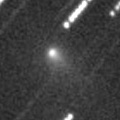
|
It was very bright and visible visually as 12.4 mag in July and early August (Aug. 2, Jakub Koukal). Now it is fading, but still bright as 14.6 mag (Sept. 29, Jakub Cerny). In the Northern Hemisphere, it keeps observable until the end of 2011 when it becomes fainter than 18 mag. It will never be observable again in the Southern Hemisphere.
Date(TT) R.A. (2000) Decl. Delta r Elong. m1 Best Time(A, h)
Oct. 8 17 30.83 34 15.9 2.041 2.055 76 15.3 18:59 (100, 58)
Oct. 15 17 31.13 34 25.0 2.140 2.086 73 15.5 18:50 (102, 55)
|
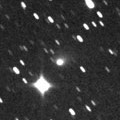
|
It brightened rapidly. Now it is bright and visible visually at 14.2 mag (Aug. 7, Alan Hale). It will be fading slowly after this. It keeps observable until winter when it fades out down to 17-18 mag.
Date(TT) R.A. (2000) Decl. Delta r Elong. m1 Best Time(A, h)
Oct. 8 20 30.10 -28 15.1 1.781 2.302 108 15.4 19:24 ( 0, 27)
Oct. 15 20 37.35 -28 2.5 1.861 2.304 103 15.5 19:04 ( 0, 27)
|
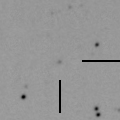
|
Now it is 17.5 mag (Aug. 17, K. Hills). It is already unobservable in the Northern Hemisphere. It is getting lower in the evening sky, and will be too low to observe in late October also in the Southern Hemisphere.
Date(TT) R.A. (2000) Decl. Delta r Elong. m1 Best Time(A, h)
Oct. 8 14 54.42 -22 42.1 2.433 1.699 34 15.5 18:59 ( 64, -3)
Oct. 15 15 14.46 -23 45.7 2.437 1.675 31 15.4 18:50 ( 63, -4)
|
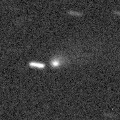
|
It was revealed to be a comet when appearing in the morning sky in early August. It has already passed the perihelion in April, and it will be fading after this. But it is still visible visually at 14.3 mag (Sept. 30, Jakub Cerny). In the Northern Hemisphere, it keeps observable in excellent condition for a long time until 2012 summer. It is not observable at all in the Southern Hemisphere.
Date(TT) R.A. (2000) Decl. Delta r Elong. m1 Best Time(A, h)
Oct. 8 10 11.82 47 52.2 2.807 2.534 64 15.5 4:35 (233, 39)
Oct. 15 10 27.72 47 45.8 2.796 2.583 67 15.6 4:41 (234, 42)
|

|
Now it is 15.5 mag (Oct. 4, Cordell-Lorenz Observatory). It will reach up to 10 mag from January to March, but it will be too low to observe. It will be getting lower in the evening sky. In the Northern Hemisphere, it keeps observable until December when it brightens up to 12 mag. In the Southern Hemisphere, it is observable only until October when it becomes 15 mag.
Date(TT) R.A. (2000) Decl. Delta r Elong. m1 Best Time(A, h)
Oct. 8 16 19.27 3 38.6 2.354 1.917 52 15.8 18:59 ( 72, 29)
Oct. 15 16 31.75 2 38.0 2.339 1.853 49 15.5 18:50 ( 72, 27)
|

|
Bright new comet. Now it is 15.7 mag (Oct. 3, Hidetaka Sato). It keeps 16 mag from October to November, but it will be fainter than 18 mag in winter. In the Northern Hemisphere, it keeps locating the same altitude in the morning sky. In the Southern Hemisphere, it locates extremely low now, but it will be getting higher gradually. Juan Jose Gonzalez reported that it was visible as a 11.3-mag diffuse comet visually on Oct. 9. The orbital elements are similar to P/2006 T1 (Levy), but they seem to be different objects.
Date(TT) R.A. (2000) Decl. Delta r Elong. m1 Best Time(A, h)
Oct. 8 9 42.76 15 54.8 1.461 1.148 51 15.9 4:35 (273, 33)
Oct. 15 10 10.05 11 32.7 1.450 1.126 50 15.8 4:41 (278, 32)
|

|
Now it is 15.8 mag (Sept. 24, C. Bell). It is expected to be observable at 13 mag for a long time from 2012 summer to 2013 summer. It will be observable in excellent condition in the Southern Hemisphere. But it is not observable at brightest time in the Northern Hemisphere. It keeps observable for a while at 16 mag while brightening gradually.
Date(TT) R.A. (2000) Decl. Delta r Elong. m1 Best Time(A, h)
Oct. 8 2 40.79 -23 50.4 3.757 4.572 140 16.0 1:37 ( 0, 31)
Oct. 15 2 33.56 -25 37.9 3.690 4.513 141 15.9 1:03 ( 0, 30)
|
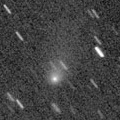
|
Now it is bright at 13.8 mag and visible visually (Sept. 2, Jakub Cerny). It will be fading slowly after this, and it will be fainter than 18 mag in December.
Date(TT) R.A. (2000) Decl. Delta r Elong. m1 Best Time(A, h)
Oct. 8 22 7.63 -30 15.4 2.949 3.636 126 16.1 21:00 ( 0, 25)
Oct. 15 22 2.05 -31 26.7 3.102 3.686 118 16.3 20:27 ( 0, 24)
|

|
It became bright as 12 mag in 2010. Now it is fading. It has already faded down to 16.3 mag (Sept. 11, Artyom Novichonok and Vladimir Gerke).
Date(TT) R.A. (2000) Decl. Delta r Elong. m1 Best Time(A, h)
Oct. 8 2 4.22 2 33.5 2.878 3.840 161 16.1 1:01 ( 0, 58)
Oct. 15 1 59.31 2 12.8 2.878 3.859 168 16.1 0:28 ( 0, 57)
|

|
Now it is 16.4 mag (Sept. 22, F. Garcia). It will be fading very slowly after this. In the Northern Hemisphere, it keeps observable for a long time until 2012 spring when it fades down to 17-18 mag. It will not be observable in the Southern Hemisphere.
Date(TT) R.A. (2000) Decl. Delta r Elong. m1 Best Time(A, h)
Oct. 8 22 26.86 47 35.5 4.736 5.406 127 16.2 21:20 (180, 77)
Oct. 15 22 25.99 46 22.0 4.776 5.436 127 16.2 20:51 (180, 79)
|

|
It brightened up to 14.0 mag and became visible visually in August (Aug. 1, Juan Jose Gonzalez). Now it is fading, but still bright as 15.3 mag (Sept. 23, Catalina Sky Survey).
Date(TT) R.A. (2000) Decl. Delta r Elong. m1 Best Time(A, h)
Oct. 8 22 53.86 -19 55.4 1.372 2.240 141 16.3 21:47 ( 0, 35)
Oct. 15 22 53.60 -19 28.2 1.441 2.259 134 16.5 21:19 ( 0, 36)
|
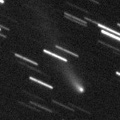
|
It reached up to 14 mag in 2010 autumn and winter. Now it is fading. It has already faded down to 16.6 mag (Sept. 14, Hidetaka Sato). In the Southern Hemisphere, it keeps observable in good condition while fading gradually. In the Northern Hemisphere, it will never be observable again.
Date(TT) R.A. (2000) Decl. Delta r Elong. m1 Best Time(A, h)
Oct. 8 6 32.42 -66 22.8 3.703 3.782 86 16.4 4:35 (355,-12)
Oct. 15 6 26.44 -69 20.6 3.747 3.823 86 16.4 4:41 (359,-14)
|

|
It brightened up to 15.0 mag and became visible visually in summer (Aug. 23, Jakub Cerny). Now it is fading, but still bright as 15.8 mag (Sept. 13, Artyom Novichonok and Vladimir Gerke).
Date(TT) R.A. (2000) Decl. Delta r Elong. m1 Best Time(A, h)
Oct. 8 17 55.47 -13 27.0 2.052 2.035 74 16.7 18:59 ( 38, 33)
Oct. 15 18 10.15 -14 2.7 2.117 2.036 71 16.8 18:50 ( 39, 32)
|

|
Now it is 17.1 mag (Sept. 13, K. Hills). In the Southern Hemisphere, it keeps observable at 16-17 mag for a long time from 2011 to 2013. In the Northern Hemisphere, it is only observable until October.
Date(TT) R.A. (2000) Decl. Delta r Elong. m1 Best Time(A, h)
Oct. 8 17 12.79 -25 11.3 5.067 4.734 65 16.8 18:59 ( 40, 17)
Oct. 15 17 15.91 -25 58.2 5.137 4.701 59 16.8 18:50 ( 43, 15)
|
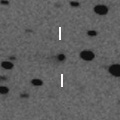
|
Now it is 17.1 mag (Sept. 25, J. F. Hernandez). It keeps observable at 17 mag for a long time from 2011 to 2012.
Date(TT) R.A. (2000) Decl. Delta r Elong. m1 Best Time(A, h)
Oct. 8 0 5.91 16 23.2 7.086 8.052 164 16.8 22:58 ( 0, 71)
Oct. 15 0 0.42 15 50.6 7.114 8.056 159 16.8 22:25 ( 0, 71)
|
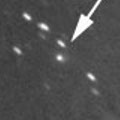
|
Now it is 16.3 mag (Sept. 24, Toshiyuki Takahashi). It will be observable at 17 mag in good condition in autumn.
Date(TT) R.A. (2000) Decl. Delta r Elong. m1 Best Time(A, h)
Oct. 8 23 15.26 -10 0.7 1.141 2.074 151 17.0 22:08 ( 0, 45)
Oct. 15 23 14.08 -10 20.9 1.173 2.065 143 17.1 21:39 ( 0, 45)
|

|
It brightened up to 13-14 mag and became visible visually from 2007 to 2009. Now it is fading. But it can be observed as bright as 16-17 mag still now. In the Northern Hemisphere, it keeps observable in excellent condition until early summer in 2012. In the Southern Hemisphere, it locates extremely low only.
Date(TT) R.A. (2000) Decl. Delta r Elong. m1 Best Time(A, h)
Oct. 8 10 53.57 35 15.1 11.351 10.729 49 17.1 4:35 (245, 28)
Oct. 15 10 54.82 35 15.2 11.305 10.765 55 17.1 4:41 (248, 34)
|

|
Now it is 17.0 mag (Sept. 22, C. Rinner, F. Kugel). It tends to be brightest after the perihelion passage. In the Northern Hemisphere, it keeps observable at 17 mag in good condition from autumn to winter. In the Southern Hemisphere, it locates low and will be hard to observe.
Date(TT) R.A. (2000) Decl. Delta r Elong. m1 Best Time(A, h)
Oct. 8 9 34.50 21 7.2 2.459 2.062 55 17.2 4:35 (269, 37)
Oct. 15 9 48.16 20 47.6 2.427 2.098 59 17.2 4:41 (272, 41)
|
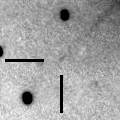
|
Now it is 17.2 mag (Sept. 23, IAA-AI Atacama). It keeps 17-18 mag until early 2013. It keeps observable in good condition until early 2012 in the Southern Hemisphere, although it locates low in the Northern Hemisphere. In the Northern Hemisphere, it will be observable in good condition from 2012 autumn to early 2013.
Date(TT) R.A. (2000) Decl. Delta r Elong. m1 Best Time(A, h)
Oct. 8 0 50.90 -47 8.6 2.639 3.340 127 17.3 23:43 ( 0, 8)
Oct. 15 0 44.89 -46 49.7 2.648 3.315 124 17.3 23:09 ( 0, 8)
|
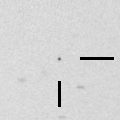
|
Peculiar asteroid moving along a cometary orbit. Now it is 17.5 mag (Aug. 1, Siding Spring Survey)�$B!#�(BIt is observable at 17-18 mag in good condition from September to November.
Date(TT) R.A. (2000) Decl. Delta r Elong. m1 Best Time(A, h)
Oct. 8 3 3.78 8 54.7 1.798 2.693 147 17.7 2:00 ( 0, 64)
Oct. 15 2 58.07 8 2.2 1.810 2.748 155 17.7 1:27 ( 0, 63)
|
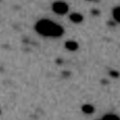
|
Now it is 18.4 mag (Sept. 30, F. Garcia). It keeps observable at 18 mag for a long time until 2013.
Date(TT) R.A. (2000) Decl. Delta r Elong. m1 Best Time(A, h)
Oct. 8 5 43.31 25 51.8 3.515 3.939 107 17.8 4:35 (355, 81)
Oct. 15 5 44.73 25 57.0 3.416 3.936 114 17.7 4:13 ( 0, 81)
|

|
Now it is 18.0 mag (Sept. 29, C. Bell). It will be observable in good condition at 18 mag from autumn to winter.
Date(TT) R.A. (2000) Decl. Delta r Elong. m1 Best Time(A, h)
Oct. 8 3 28.85 -9 6.5 3.260 4.061 138 17.7 2:25 ( 0, 46)
Oct. 15 3 26.84 -10 11.7 3.214 4.055 143 17.7 1:55 ( 0, 45)
|
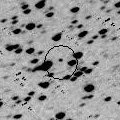
|
Peculiar asteroid moving along a cometary orbit. It keeps observable at 18 mag for a long time from 2008 to 2014.
Date(TT) R.A. (2000) Decl. Delta r Elong. m1 Best Time(A, h)
Oct. 8 8 15.44 6 41.6 6.833 6.562 70 17.8 4:35 (299, 44)
Oct. 15 8 16.19 6 53.7 6.723 6.566 76 17.8 4:41 (308, 50)
|
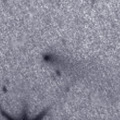
|
Although the condition is bad in this apparition, it brightened up to 12.8 mag in last winter (Dec. 24, Ken-ichi Kadota). Now it is fading, but it is still bright as 16.7 mag (Sept. 22, P. Dupouy). It can be observable at 17-18 mag for some more time.
Date(TT) R.A. (2000) Decl. Delta r Elong. m1 Best Time(A, h)
Oct. 8 23 39.18 -18 39.8 1.845 2.754 149 18.3 22:32 ( 0, 36)
Oct. 15 23 34.50 -18 30.1 1.931 2.793 143 18.6 21:59 ( 0, 37)
|
|
![]()
 C/2011 M1 ( LINEAR )
C/2011 M1 ( LINEAR ) 49P/Arend-Rigaux
49P/Arend-Rigaux C/2009 F4 ( McNaught )
C/2009 F4 ( McNaught ) C/2011 Q2 ( McNaught )
C/2011 Q2 ( McNaught ) C/2011 A3 ( Gibbs )
C/2011 A3 ( Gibbs ) 213P/2009 B3 ( Van Ness )
213P/2009 B3 ( Van Ness ) (596) Scheila
(596) Scheila C/2006 S3 ( LONEOS )
C/2006 S3 ( LONEOS ) 29P/Schwassmann-Wachmann 1
29P/Schwassmann-Wachmann 1 71P/Clark
71P/Clark C/2010 S1 ( LINEAR )
C/2010 S1 ( LINEAR ) C/2010 M1 ( Gibbs )
C/2010 M1 ( Gibbs ) C/2011 L3 ( McNaught )
C/2011 L3 ( McNaught ) 48P/Johnson
48P/Johnson 37P/Forbes
37P/Forbes P/2010 JC81 ( WISE )
P/2010 JC81 ( WISE ) 21P/Giacobini-Zinner
21P/Giacobini-Zinner C/2011 S2
C/2011 S2 C/2011 R1 ( McNaught )
C/2011 R1 ( McNaught ) C/2009 Y1 ( Catalina )
C/2009 Y1 ( Catalina ) 65P/Gunn
65P/Gunn C/2008 FK75 ( Lemmon-Siding Spring )
C/2008 FK75 ( Lemmon-Siding Spring ) 130P/McNaught-Hughes
130P/McNaught-Hughes C/2010 B1 ( Cardinal )
C/2010 B1 ( Cardinal ) 115P/Maury
115P/Maury C/2011 O1 ( LINEAR )
C/2011 O1 ( LINEAR ) C/2008 S3 ( Boattini )
C/2008 S3 ( Boattini ) P/2011 R2 ( PanSTARRS )
P/2011 R2 ( PanSTARRS ) C/2005 L3 ( McNaught )
C/2005 L3 ( McNaught ) 164P/Christensen
164P/Christensen P/2011 N1 ( ASH )
P/2011 N1 ( ASH ) 2000 EJ37
2000 EJ37 244P/2010 Q1 ( Scotti )
244P/2010 Q1 ( Scotti ) 242P/2010 P3 ( Spahr )
242P/2010 P3 ( Spahr ) 2008 YB3
2008 YB3 9P/Tempel 1
9P/Tempel 1![]()









































